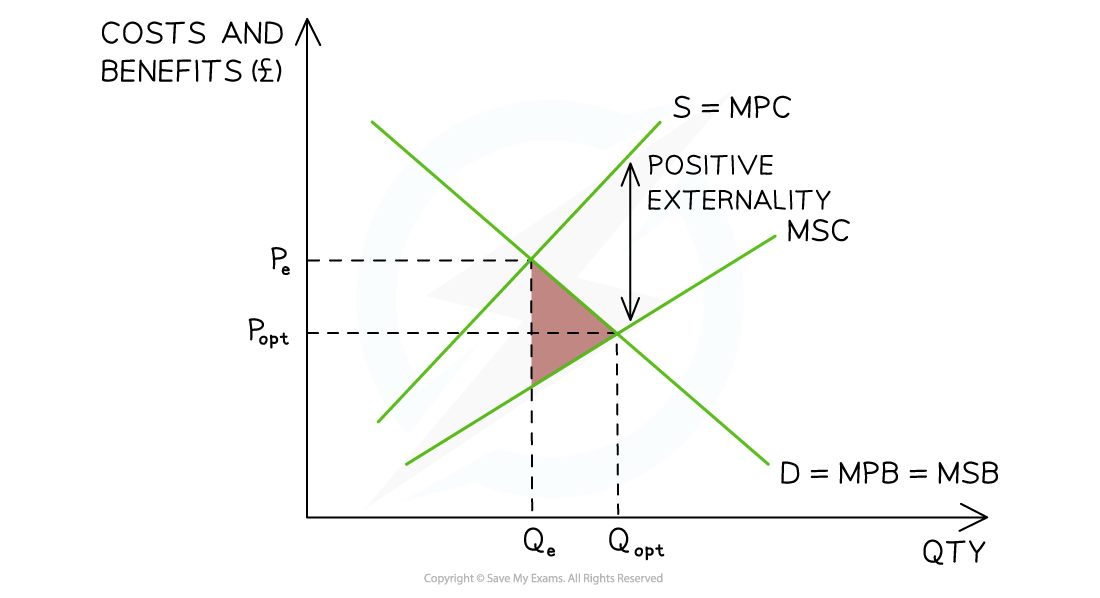Positive Externalities of Production
- Positive externalities of production are sometimes created during the production of a good/service
- The market is failing due to under-provision of these goods/services as only the private benefits are considered by the producers and not the external benefits
- If the external benefits were considered, the supply would increase and they would be sold at a lower price
- E.g. The production of honey increases the amount of bees in an area which increases pollination potentially helping other food producers in the area

External benefits of production (positive externality) result in an under-provision shown by the gap between Qopt and Qe
Diagram Analysis
- The marginal social benefit (MSB) is assumed to be equal to the marginal private benefit (MPB) as the focus is on the producer side of the market
- The free-market equilibrium can be seen at PeQe. This is where the MPC = MSB
- The larger the external benefits in production, the larger the gap between the MPC and the marginal social cost (MSC)
- The optimum allocation of resources from society’s point of view would generate an equilibrium where MSB = MSC. This can be found at PoptQopt. There is no market failure at this equilibrium
- The free market is failing due to under-provision of this good/service equal to Qopt - Qe
- There is a welfare loss to society (pink triangle) as the external benefits could be further maximised
- To be socially efficient, more factors of production should be allocated to producing this good/service
- There is an opportunity for government intervention (indirect taxes, legislation, regulation etc.), to force this market to be more socially efficient
- Any intervention that reduces the welfare loss will be beneficial
Positive Externalities of Consumption
- Positive externalities of consumption are created during the consumption of a good/service (merit goods)
- The market is failing due to under-consumption of these goods/services as only the private benefits are considered by the consumers and not the external benefits
- If the external benefits were considered, the demand would increase and they would be sold at a higher price
- E.g. Vaccinations protect those who receive them, but also prevent the spread of disease to others around them

External benefits of consumption (positive externality) result in an under-consumption represented by the gap between Qe and Qopt
Diagram Analysis
- MSC is assumed to be equal to the MPC as the focus is on the consumer side of the market
- The free-market equilibrium can be seen at PeQe. This is where the MPB = MSC
- The larger the external benefits in consumption (positive externality), the larger the gap between the MPB and MSB
- The optimal allocation of resources from society’s point of view would generate an equilibrium where MSB = MSC. This can be found at PoptQopt. There is no market failure here
- The free market is failing due to an under-consumption of this good/service equal to Qopt - Qe
- More factors of production should be allocated to producing the optimal quantity as societal welfare will be gained (pink triangle)
- There is an opportunity for government intervention (subsidies, partial provision etc.) to force this market to be more socially efficient
- Any intervention that gains welfare will be beneficial
Exam Tip
Memorise this distinction and it will help you to draw the correct diagram and to provide appropriate analysis.
When the external benefit or cost is on the producer side, there will be two supply curves.
When the benefit or cost is on the consumer side, there will be two demand curves.
Merit Goods
- Market Failure occurs when free market activity results in a less than optimum allocation of resources from the point of view of society
- Merit goods are beneficial to society but consumers under-consume them as they do not fully recognise the private or external benefits. E.g. Vaccinations, education, electric cars
- They are under-provided in a market and their consumption generates both private and/or external benefits
- Governments often have to subsidise these goods in order to lower the price and/or increase the quantity demanded